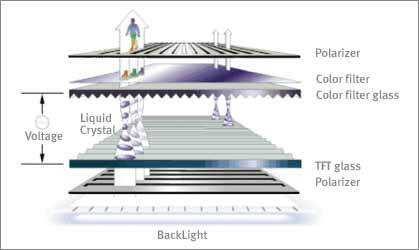For a more in-depth explanation:
You got the concept wrong when you imagined it to be millions of LEDs flashing the different hues of colors to give you a display - all these kind of monitors are made of invariably 2 layers - a front layer of LCD (Liquid Crystal Display or Liquid Crystal Diode) that makes up the dots you see as pixels, along with the display of color.

This LCD layer is then back-lighted using light tubes at the back, giving it brightness. Formerly, LCD displays use to use CCFL (Cold Cathode Flourescent Lamp) as a light source at the back, but however in recent years there has been a marked shift towards the use of LED (Light Emitting Diode) as a back-light source. The advantages of LEDs are as follows:
- Faster Turn On: LEDs can reach
maximum brightness faster than
CCFLs, in fact almost instantly.
- More Neutral Colors: CCFLs are known
to give a warm/yellowish tint. LEDs
have a more neutral whitepoint.
- Brighter: LEDs are brighter
generally than CCFLs, thus allowing
a display to achieve even higher
maximum brightness.
- Thinner: The
reason LEDs are coming into
prominence is that it was driven by
the notebook sectors - LED
back-lighting can be made thinner
than CCFL back-lighting.
- Longer-Lasting: Apparently, LEDs are
rated for more life than CCFLs. Also
the degradation over time is less
severe than CCFLs.
Well, these are the primary reasons why LED-based LCDs are considered to be better than CCFLs. They still come with a price premium though.

Note that although "LED monitors" are not what you once imagined them to be, "OLED monitors" are actually exactly that: millions of tiny (organic, hence the "O") LEDs forming subpixels of the screen. Yes, marketing is confusing. – Ruslan – 2019-12-01T10:16:12.590